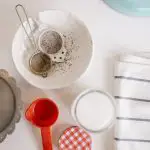To air out smelly fabrics, start by identifying the odor’s source, like mildew or sweat. Then, hang the items outside on a breezy day to let fresh air work its magic. Baking soda can absorb tough odors, while a vinegar solution may freshen delicate fabrics. Don’t forget to wash and air dry whenever possible. For long-term freshness, learn proper storage methods to keep fabrics smelling great. More tips await you to enhance your results!
Table of Contents
Key Takeaways
- Hang fabrics outside on a breezy day to promote airflow and disperse trapped odors effectively.
- Utilize direct sunlight, which enhances the odor elimination process without damaging fabrics.
- Inspect fabrics for stains or mildew before airing them out to target specific odor sources.
- Rotate or flip items while outside to ensure even exposure to fresh air and sunlight.
- Consider storing fabrics in breathable containers to maintain freshness and prevent future odors.
Identify the Source of the Odor
Before you can effectively air out smelly fabrics, you need to identify the source of the odor. Start by inspecting the fabric closely.
Identifying the source of odor is crucial for effectively airing out smelly fabrics. Inspect them closely for mildew, stains, and more.
Check for any signs of mildew, sweat, or food stains. Sometimes, the smell lingers due to improper washing or storage. If the fabric is clothing, consider how long it’s been worn or if it’s been stored in a damp environment.
Smells can also come from pets or smoke, so think about where the fabric has been used. Once you pinpoint the source, you’ll know whether it’s a simple wash or a more thorough cleaning that’s needed.
Tackling the right cause helps guarantee you get rid of the smell effectively when you air out those fabrics.
Fresh Air Exposure
To effectively eliminate odors from smelly fabrics, exposing them to fresh air is a simple yet powerful solution. Just hang your fabrics outside, and let nature work its magic. Fresh air helps disperse trapped odors, leaving your items smelling crisp and clean.
Here are some tips to maximize fresh air exposure:
- Choose a breezy day to enhance airflow.
- Hang items in direct sunlight for added effectiveness.
- Avoid damp or humid conditions, as they can trap odors.
- Rotate or flip items occasionally to guarantee even exposure.
Baking Soda Treatment
While fresh air is a great start, a baking soda treatment can take odor elimination to the next level.
Simply sprinkle a generous amount of baking soda onto the smelly fabric, ensuring it covers the affected areas. Let it sit for at least 15 minutes, or longer for tougher odors.
Baking soda works by absorbing unwanted smells, leaving your fabric fresher. After the waiting period, shake or brush off the baking soda, then check if the odor persists. If needed, repeat the process.
For added effectiveness, combine baking soda with a little water to form a paste, applying it directly to stubborn spots. This method’s easy, natural, and often brings impressive results for your smelly fabrics.
Vinegar Solution
Vinegar’s odor-neutralizing properties make it a powerful tool for freshening up smelly fabrics.
To get the best results, you’ll want to mix it in the right ratios and apply it effectively.
Let’s explore how you can use this simple solution to tackle those stubborn odors.
Vinegar’s Odor Neutralizing Properties
If you’re struggling with stubborn odors in your fabrics, a vinegar solution can be a game changer.
Vinegar’s natural acidity helps break down odor-causing compounds, making it an effective and eco-friendly option for freshening up your items.
Here are some reasons why vinegar works wonders:
- Neutralizes smells: It tackles various odors, from musty to sweat.
- Safe for most fabrics: Unlike harsh chemicals, vinegar is gentle on materials.
- Cost-effective: It’s an affordable solution that you probably already have at home.
- Easy to use: Simply mix it with water or add it to your laundry routine.
With vinegar, you can breathe new life into your fabrics and enjoy a fresher home environment.
Mixing Ratios for Effectiveness
To maximize the effectiveness of vinegar in combating odors, knowing the right mixing ratios is key. A common and effective solution is to mix one part white vinegar with three parts water. This ratio strikes a balance that’s potent enough to neutralize smells without being overly harsh on fabrics.
If you’re dealing with particularly stubborn odors, you can adjust the ratio to a 1:2 mix, increasing vinegar’s presence for added strength. For lighter scents or delicate fabrics, stick to the 1:4 ratio to guarantee gentleness.
Application Techniques to Use
Once you’ve mixed your vinegar solution, applying it effectively can make all the difference in odor removal. Here are some techniques to maximize your efforts:
- Spray Method: Lightly mist the solution on the fabric, ensuring even coverage without soaking.
- Soaking: For stubborn odors, soak the fabric in the solution for 30 minutes before rinsing.
- Spot Treatment: Use a cloth to apply the solution directly to particularly smelly areas.
- Air Drying: After application, hang the fabric outside to dry in fresh air, enhancing the odor-fighting power.
These techniques not only help eliminate odors but also refresh your fabrics, leaving them smelling clean and crisp.
Try them out and enjoy the results!
Essential Oils for Fragrance
Essential oils offer a natural and effective way to infuse fragrance into your fabrics. To get started, choose your favorite oils, such as lavender, eucalyptus, or tea tree, known for their pleasant scents and antibacterial properties.
You can create a fabric spray by mixing a few drops of essential oil with water in a spray bottle. Lightly mist your fabrics, ensuring they’re not soaked. Alternatively, place a few drops on cotton balls and tuck them into drawers or closets to keep your items smelling fresh.
Remember to test a small area first to avoid any potential staining. Using essential oils not only masks odors but also adds a therapeutic touch to your living space, making it feel more inviting.
Washing Techniques
After using essential oils to freshen up your fabrics, it’s important to guarantee they stay clean and odor-free. To achieve this, adopt effective washing techniques that tackle any lingering smells.
Here are some tips to take into account:
- Sort your laundry: Separate fabrics by color and type to prevent damage and guarantee a thorough clean.
- Use the right detergent: Choose a high-quality detergent designed to eliminate odors.
- Wash in hot water: If the fabric allows, use hot water to help break down any stubborn smells.
- Add baking soda or vinegar: These natural ingredients can enhance your detergent’s effectiveness, neutralizing odors.
Drying in the Sun
When you dry your fabrics in the sun, not only do you harness the power of natural UV rays to eliminate odors, but you also help whiten whites and brighten colors.
Sunlight acts as a natural deodorizer, breaking down the molecules that cause smells. You can maximize this effect by hanging your items outside on a breezy day, allowing fresh air to circulate.
Sunlight naturally deodorizes fabrics, breaking down odor-causing molecules while fresh air enhances the effect on breezy days.
Just make certain to avoid leaving fabrics out for too long, as prolonged exposure can fade colors. For best results, choose a sunny spot and turn the fabrics occasionally to guarantee even drying.
After a few hours, you’ll notice your fabrics smelling fresh and looking vibrant, making sun drying an effective and eco-friendly solution.
Proper Storage Tips
When it comes to storing your fabrics, you want to keep them fresh and odor-free.
Choose breathable containers to allow air circulation, and consider using moisture absorbers to combat dampness.
Finally, make sure to store your items in cool areas to prevent unwanted smells from developing.
Choose Breathable Containers
To keep your fabrics fresh and odor-free, you should choose breathable containers for storage. Unlike plastic bins, breathable options allow air circulation, preventing moisture buildup that causes unpleasant smells.
Here are some great choices to take into account:
- Cotton storage bags: Lightweight and washable, they’re perfect for short-term storage.
- Woven baskets: These add a decorative touch and promote airflow, keeping your fabrics dry.
- Mesh garment bags: Ideal for hanging items, they protect from dust while allowing breathability.
- Linen or canvas boxes: Durable and stylish, they can store larger items without trapping odors.
Use Moisture Absorbers
Moisture absorbers are key players in keeping your fabrics fresh and free from odors. Using products like silica gel packets, activated charcoal, or baking soda can help absorb excess moisture in your storage spaces.
Place these absorbers in your fabric containers or closets to combat musty smells. Remember to replace them regularly to maintain their effectiveness.
When you store items, consider spreading some baking soda directly on the fabric for added freshness. It’s a simple, cost-effective way to neutralize odors.
For larger items, you might want to invest in reusable moisture-absorbing bags. These strategies will help guarantee your fabrics stay dry and smell pleasant, making them ready for use whenever you need them.
Store in Cool Areas
Storing fabrics in cool areas can greatly enhance their longevity and freshness.
When choosing a storage space, consider these tips to keep your fabrics smelling great:
- Avoid damp places: Moisture can lead to mildew, which causes unpleasant odors.
- Keep away from sunlight: Direct sunlight can fade colors and weaken fibers over time.
- Maintain ventilation: Make certain your storage area has good air circulation to prevent musty smells.
- Use breathable bags: Opt for cotton or linen bags instead of plastic, as they allow fabrics to breathe.
Following these simple guidelines helps preserve your fabrics, keeping them fresh and ready to wear whenever you need them!
Frequently Asked Questions
Can I Use Fabric Softener After Airing Out Smelly Fabrics?
Yes, you can use fabric softener after airing out smelly fabrics. Just make sure the smell is gone first. Adding softener enhances the scent and softness, making your fabrics feel fresh and pleasant again.
How Often Should I Air Out My Fabrics?
You probably think airing out fabrics is just a one-time deal, right? In reality, you should air them out regularly, especially after use or when stored, to keep them fresh and odor-free. It’s that simple!
Do Air Fresheners Help Eliminate Odors in Fabrics?
Air fresheners can mask odors temporarily, but they don’t eliminate them from fabrics. You’re better off using proper cleaning methods or airing out your items to truly tackle those stubborn smells effectively.
Are There Specific Fabrics That Hold Odors More Than Others?
Yes, certain fabrics like polyester and nylon tend to hold odors more than natural fibers. You might notice that materials such as cotton or linen breathe better and often release smells more effectively when aired out.
What Should I Avoid When Treating Smelly Fabrics?
Treating smelly fabrics is like walking a tightrope; avoid harsh chemicals that can damage fibers, skipping thorough cleaning steps, and using high heat. Instead, opt for gentle solutions that preserve fabric integrity while eliminating odors effectively.
- Do Percale Sheets Wrinkle? Tips and Tricks for a Smoother Bed - July 14, 2025
- What Is Heathered Percale Cotton? An Explanation of the Style - July 14, 2025
- What Is Peached Percale Cotton? A Softer Take on a Classic - July 14, 2025







